Quantitative-Qualitative Method for Quick Assessment of Geodiversity
Abstract
1. Introduction
2. Materials and Methods
2.1. Aim
2.2. The Sample Area
2.2.1. General Geographical Presentation
2.2.2. Geomorphology
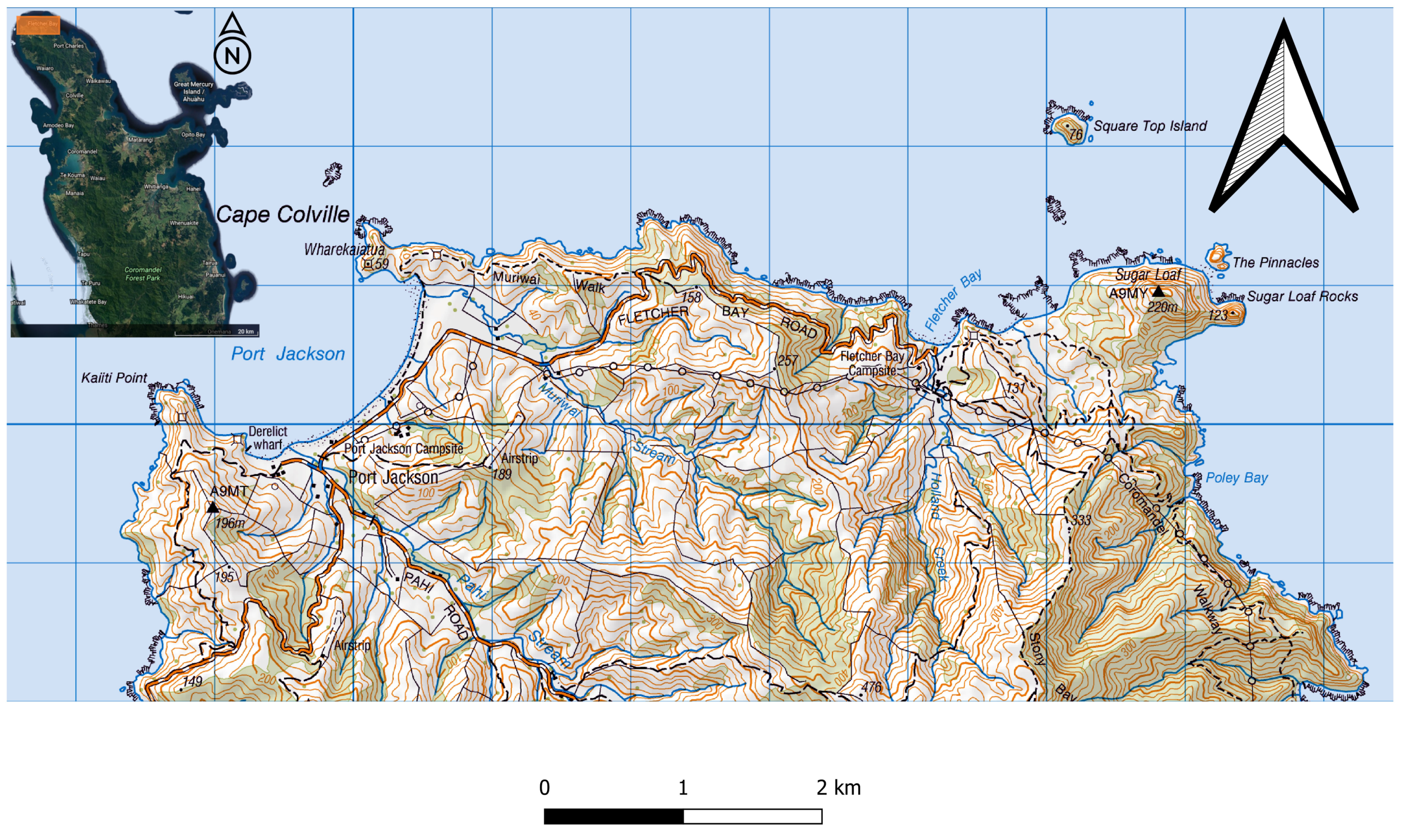
2.2.3. Geology
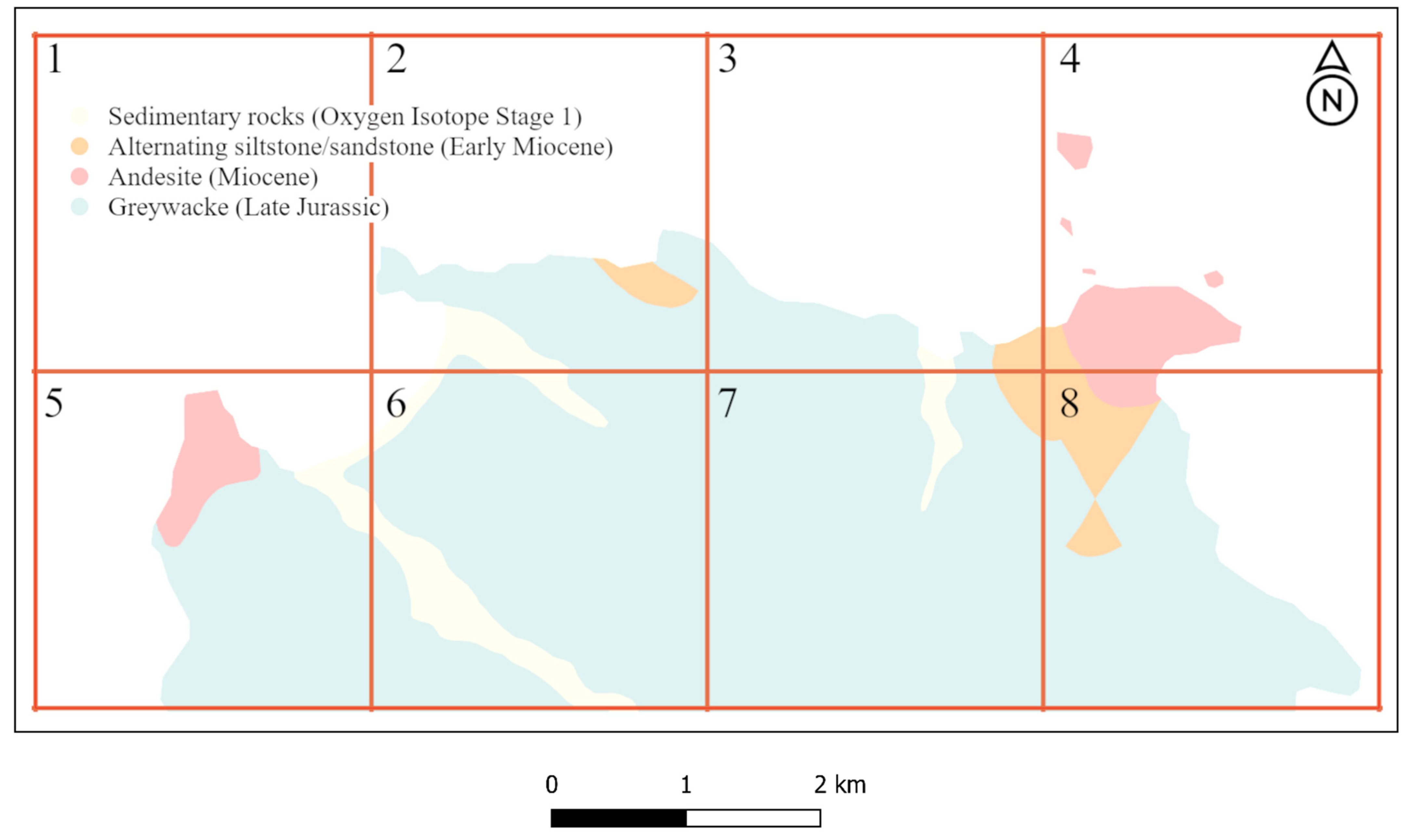
2.3. Method
2.4. Scale of Research
2.5. Equation
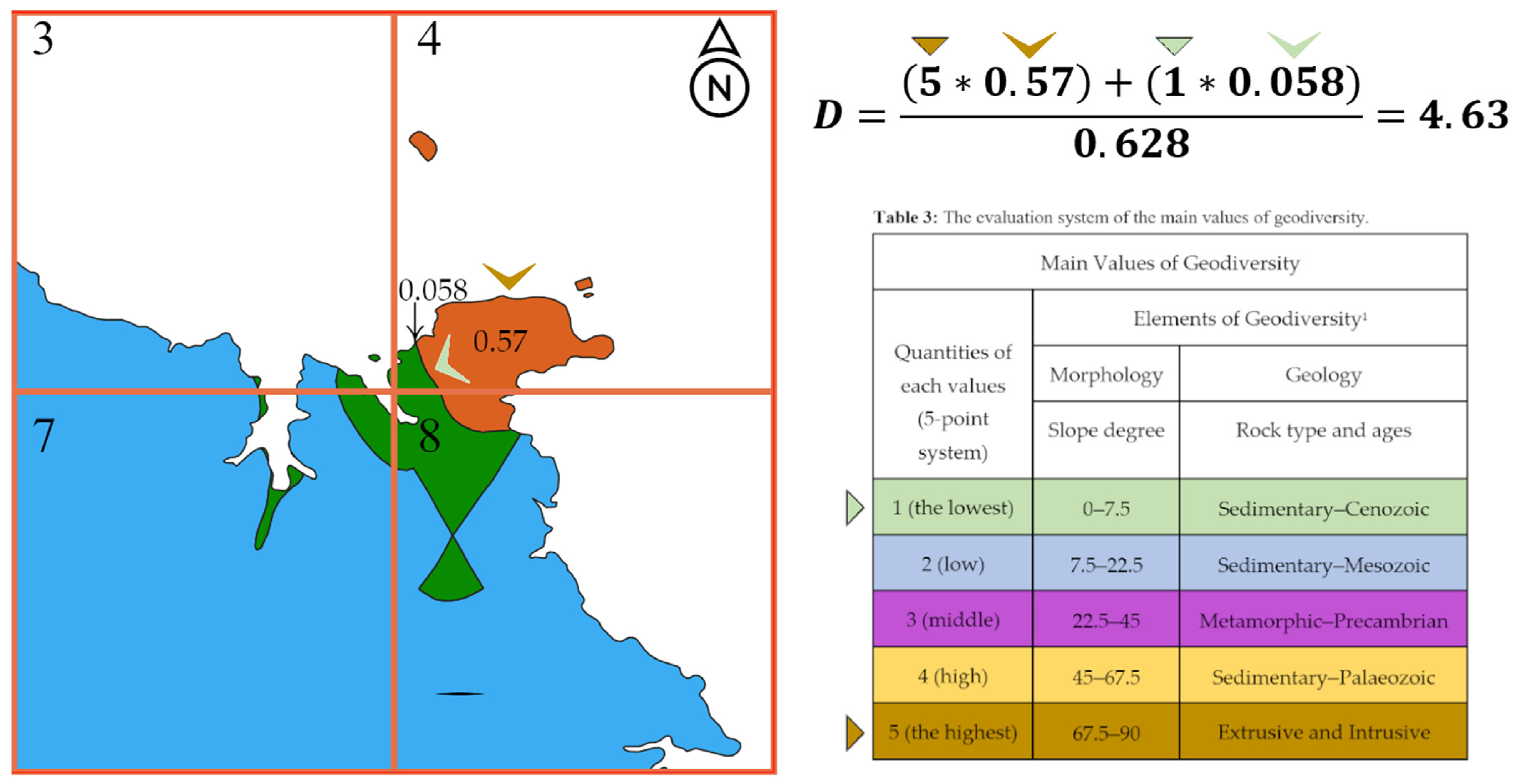
2.6. The Data for Assessment
- Geological map model 1:250,000 (as vector polygons). We used Geological Qmap of the Auckland area 1:250,000 [27] to create a polygon file (SHP format) (Figure 3) using the drawing tool in QGIS freeware (https://qgis.org/en/site/, accessed on 1 August 2021).
- DEM (or vector of elevation model). In our research, we used the vector (SHP format) of contour lines file of elevation of the territory based on the topographic map (Moehau NZTopo-AZ34) (1:50,000 scale) of studied territory [51] (Figure 2), 8m Digital Elevation Model (DEM) (https://data.linz.govt.nz/layer/51768-nz-8m-digital-elevation-model-2012/, accessed on 2 August 2021), and SRTM 1-Arc-Second Global (https://earthexplorer.usgs.gov/, accessed on 2 August 2021).
- As mentioned above, GIS software such as QGIS (https://qgis.org/en/site/, accessed on 5 August 2021), Grass GIS (https://grass.osgeo.horg/, accessed on 5 August 2021), SAGA GIS, EASY trace can be used for preparation of vector files (SHP format) [51].
- Excel Office is a good, user-friendly and popular software from Microsoft. This program contains many calculating algorithms, which can be used for any kind of assessment research.
2.7. The Assessment of Geomorphology
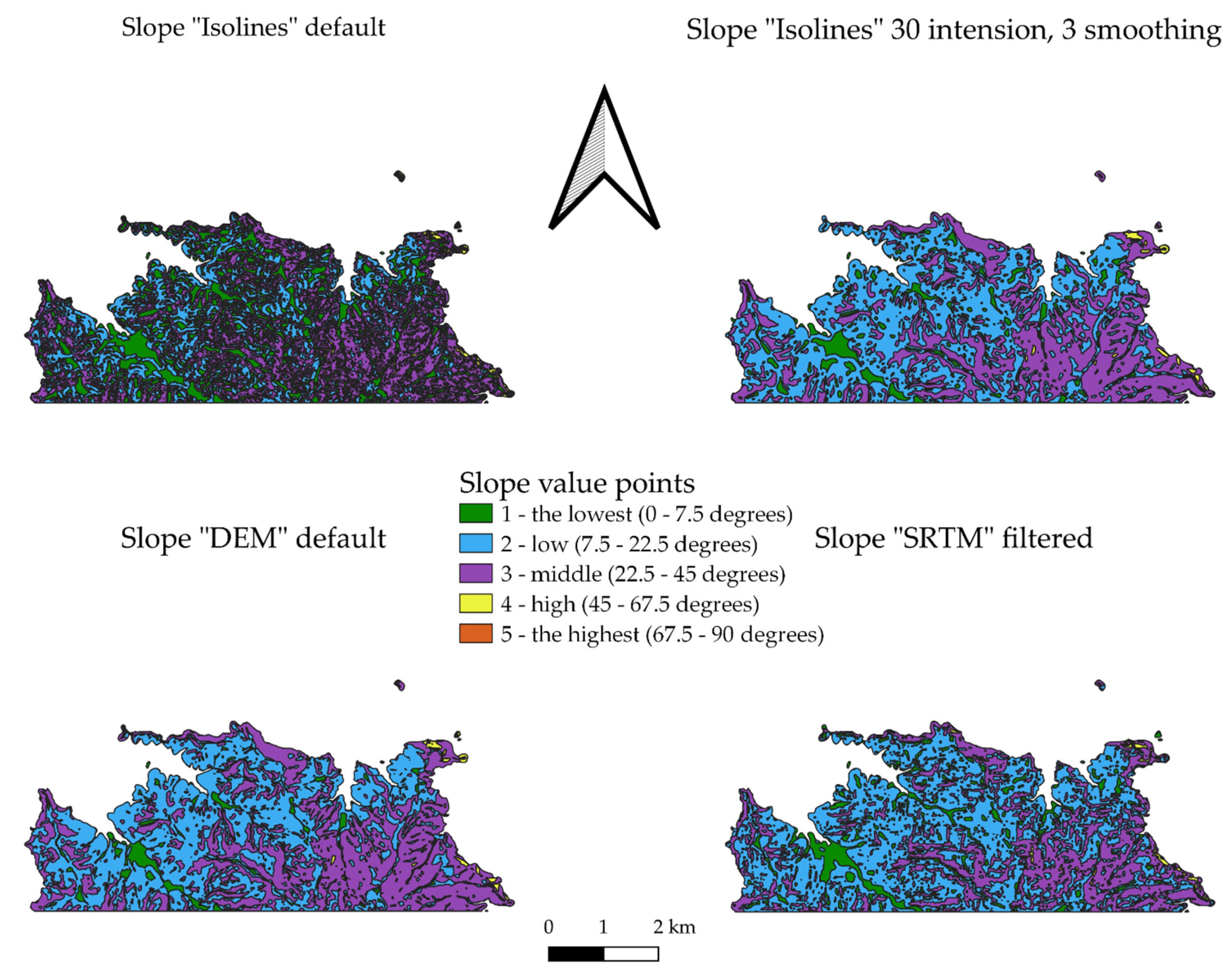
- Slope “Isolines” default—source: contour lines vector model; generation module: v.surf.rst (GRASS GIS), with default parameters.
- Slope “Isolines” 30 intention, 3 smoothing—source: contour lines vector model; generation module: v.surf.rst module (GRASS GIS), with additional 30 intention parameter and 3 smoothing parameters.
- Slope “DEM” default—source: 8 m DEM (LINZ); generation module: r.slope.aspect module (GRASS GIS), with default parameters.
- Slope “SRTM” filtered—source: SRTM 1-Arc-Second Global; filtered by with MDenoise; transformation to point-vector module: r. random; generation module: v.surf.rst module (GRASS GIS), with additional 30 intention parameter and 3 smoothing parameters.
2.8. The Assessment of Geology
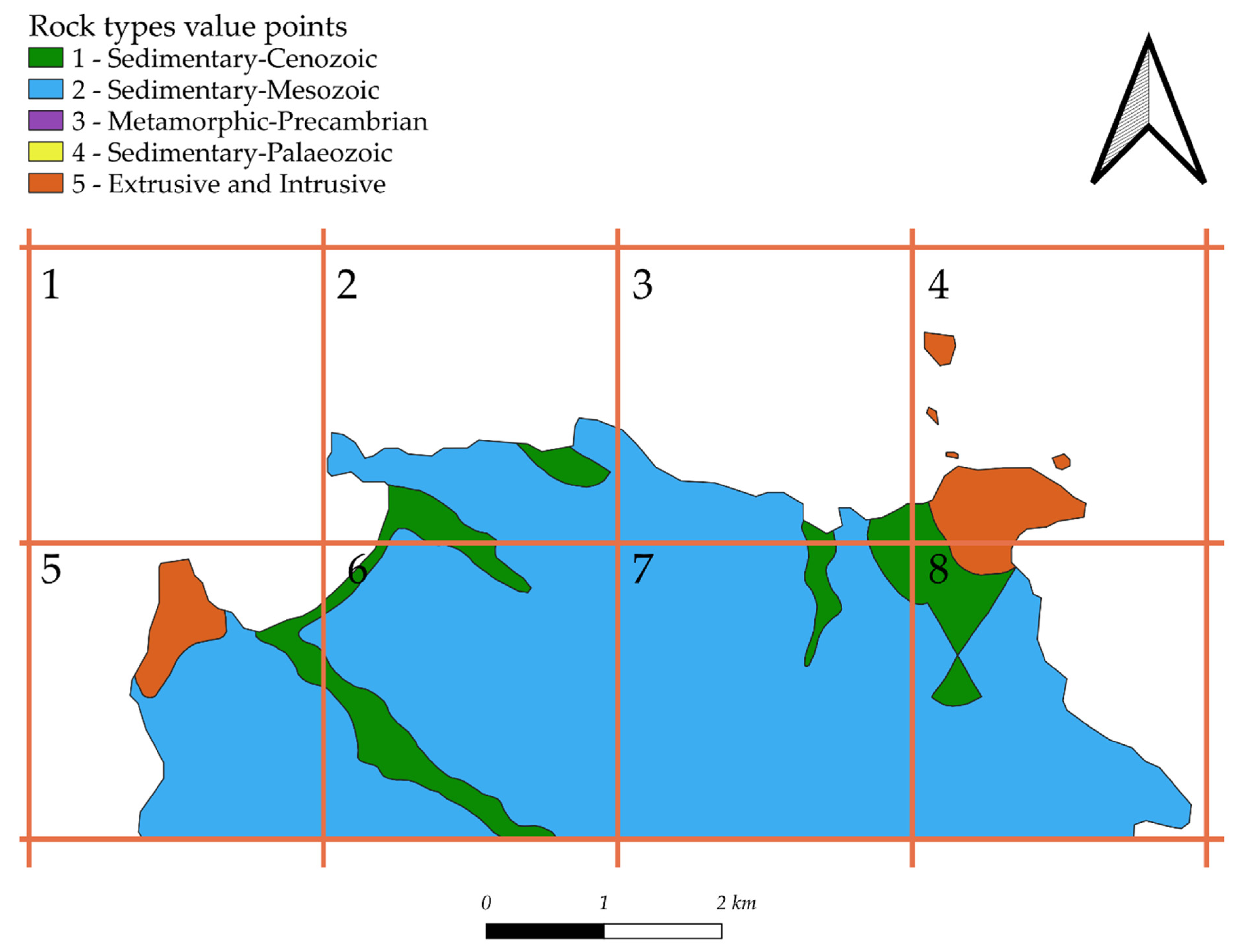
3. Results
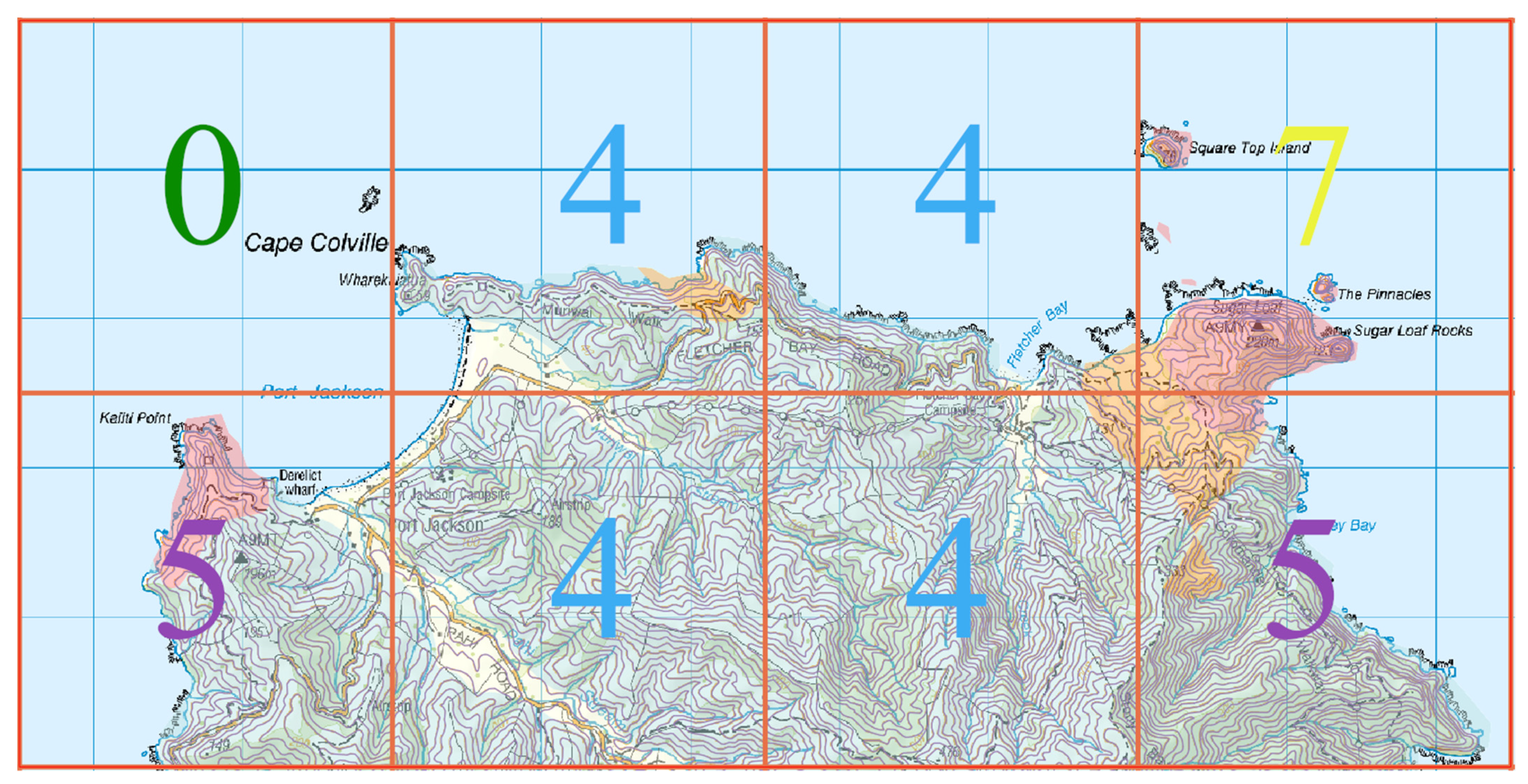
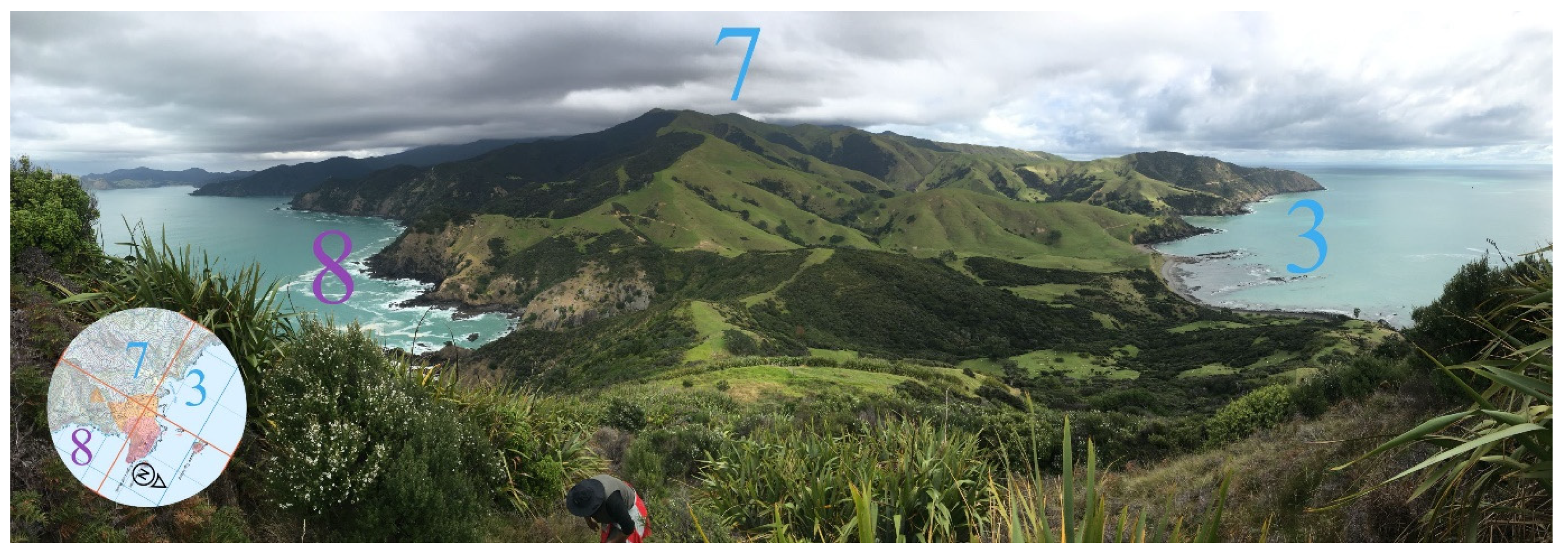
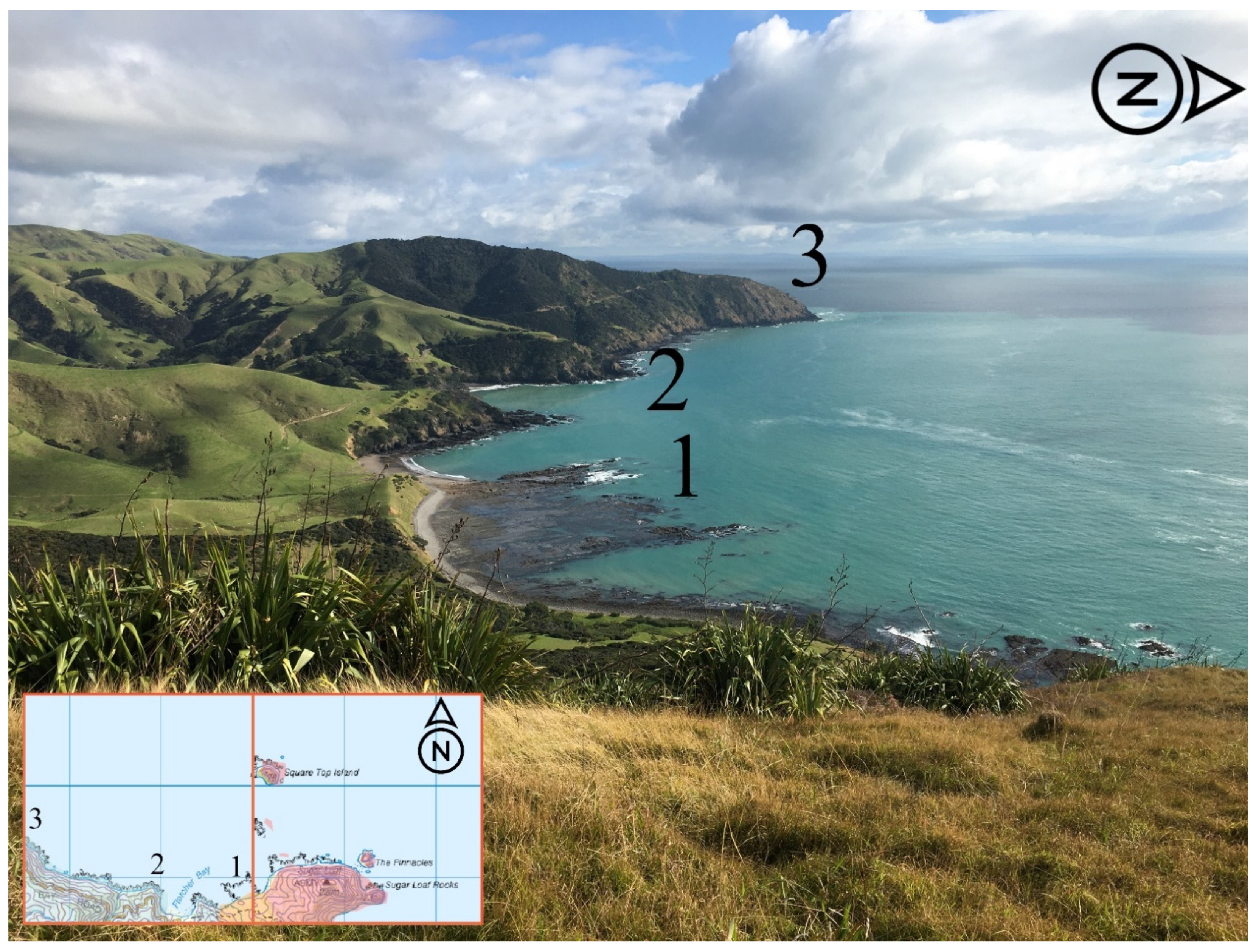
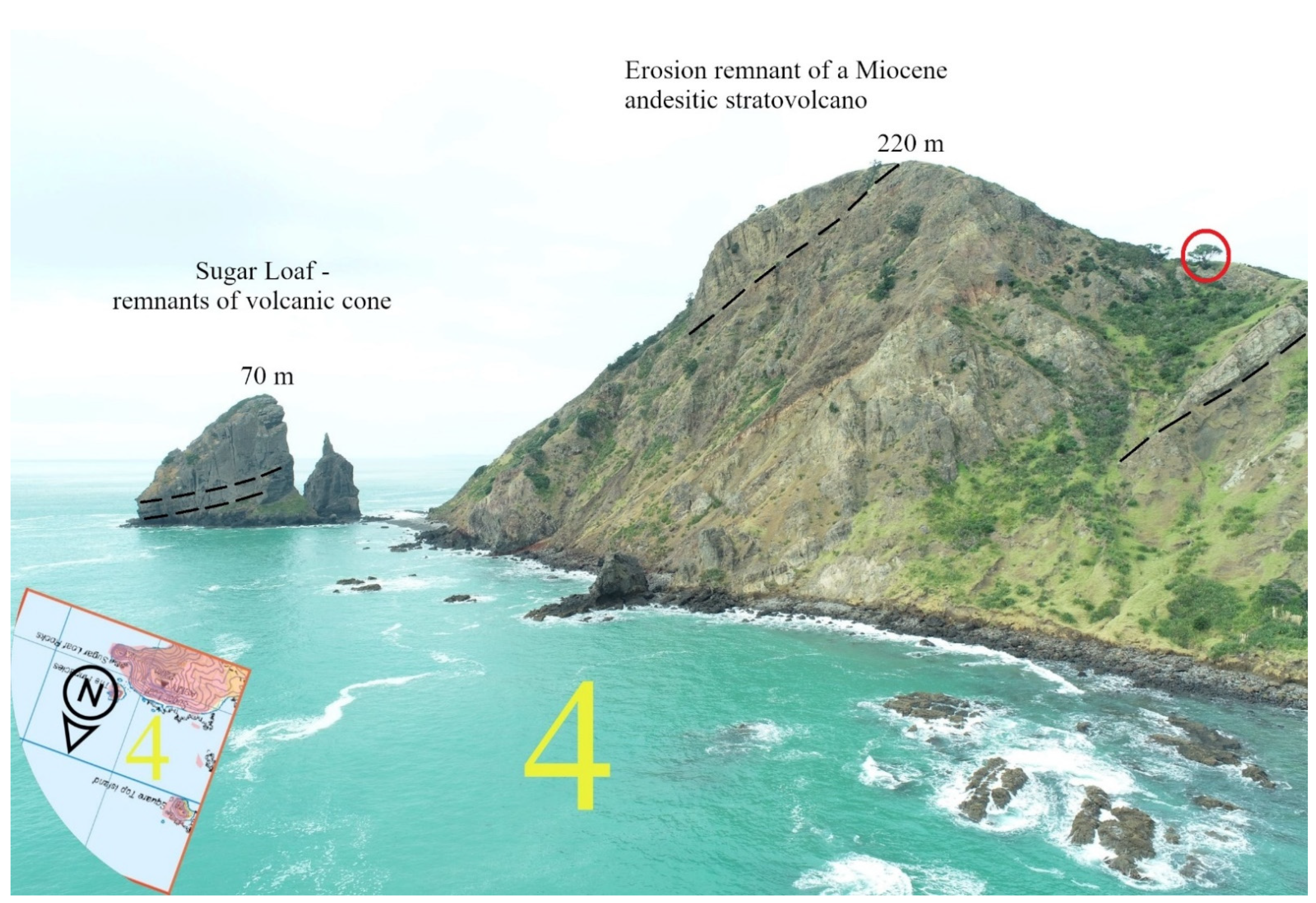
4. Discussion
5. Conclusions
Author Contributions
Funding
Data Availability Statement
Acknowledgments
Conflicts of Interest
References
- Dias, M.C.S.S.; Domingos, J.O.; dos Santos Costa, S.S.; do Nascimento, M.A.L.; da Silva, M.L.N.; Granjeiro, L.P.; de Lima Miranda, R.F. Geodiversity Index Map of Rio Grande do Norte State, Northeast Brazil: Cartography and Quantitative Assessment. Geoheritage 2021, 13, 10. [Google Scholar] [CrossRef]
- Pereira, D.I.; Pereira, P.; Brilha, J.; Santos, L. Geodiversity assessment of Paraná State (Brazil): An innovative approach. Environ. Manag. 2013, 52, 541–552. [Google Scholar] [CrossRef] [PubMed]
- Reverte, F.C.; Motta Garcia, M.d.G.; Brilha, J.; Pellejero, A.U. Assessment of impacts on ecosystem services provided by geodiversity in highly urbanised areas: A case study of the Taubate Basin, Brazil. Environ. Sci. Policy 2020, 112, 91–106. [Google Scholar] [CrossRef]
- Gray, M. Geoheritage 1. Geodiversity: A new paradigm for valuing and conserving geoheritage. Geosci. Can. 2008, 35, 51–59. [Google Scholar]
- Kozłowski, S. Geodiversity. The concept and scope of geodiversity. Przegląd Geol. 2004, 52, 833–837. [Google Scholar]
- Serrano, E.; Ruiz-Flaño, P. Geodiversity: A theoretical and applied concept. Geogr. Helv. 2007, 62, 140–147. [Google Scholar] [CrossRef]
- Gray, M. Geodiversity and geoconservation: What, why, and how? Georg. Wright Forum 2005, 22, 4–12. [Google Scholar]
- Ollier, C. Problems of geotourism and geodiversity. Quaestiones Geographicae 2012, 31, 57–61. [Google Scholar] [CrossRef]
- Da Silva, M.L.N.; do Nascimento, M.A.L.; Mansur, K.L. Quantitative assessments of geodiversity in the area of the Seridó Geopark Project, Northeast Brazil: Grid and centroid analysis. Geoheritage 2019, 11, 1177–1186. [Google Scholar] [CrossRef]
- Bétard, F.; Peulvast, J.-P. Geodiversity hotspots: Concept, method and cartographic application for geoconservation purposes at a regional scale. Environ. Manag. 2019, 63, 822–834. [Google Scholar] [CrossRef]
- Silva, J.P.; Pereira, D.I.; Aguiar, A.M.; Rodrigues, C. Geodiversity assessment of the Xingu drainage basin. J. Maps 2013, 9, 254–262. [Google Scholar] [CrossRef]
- Hayward, B.W. Out of the Ocean. Into the Fire: History in the Rocks, Fossils and Landforms of Auckland, Northland and Coromandel; Geoscience Society of New Zealand: Wellington, New Zealand, 2017; p. 336. [Google Scholar]
- Homer, L.; Moore, P.R. Vanishing Volcanoes: A Guide to the Landforms and Rock Formations of Coromandel Peninsula; Landscape Publications: Wellington, New Zealand, 1992; p. 97. [Google Scholar]
- Marden, M.; Rowan, D. The effect of land use on slope failure and sediment generation in the Coromandel region of New Zealand following a major storm in 1995. N. Z. J. For. Sci. 2015, 45, 10. [Google Scholar] [CrossRef]
- Schneider, P.; Glavovic, B.; Farrelly, T. So close yet so far apart: Contrasting climate change perceptions in two "neighboring" coastal communities on Aotearoa New Zealand’s Coromandel Peninsula. Environments 2017, 4, 65. [Google Scholar] [CrossRef]
- Booden, M.A.; Smith, I.E.; Mauk, J.L.; Black, P.M. Geochemical and isotopic development of the Coromandel Volcanic Zone, northern New Zealand, since 18 Ma. J. Volcanol. Geotherm. Res. 2012, 219, 15–32. [Google Scholar] [CrossRef]
- Mortimer, N.; Campbell, H.; Tulloch, A.; King, P.; Stagpoole, V.; Wood, R.; Rattenbury, M.; Sutherland, R.; Adams, C.; Collot, J. Zealandia: Earth’s hidden continent. GSA Today 2017, 27, 27–35. [Google Scholar] [CrossRef]
- Mortimer, N.; Rattenbury, M.; King, P.; Bland, K.; Barrell, D.; Bache, F.; Begg, J.; Campbell, H.; Cox, S.; Crampton, J. High-level stratigraphic scheme for New Zealand rocks. N. Z. J. Geol. Geophys. 2014, 57, 402–419. [Google Scholar] [CrossRef]
- Briggs, R.; Fulton, B. Volcanism, structure, and petrology of the Whiritoa-Whangamata coastal section, Coromandel Volcanic Zone, New Zealand: Facies model evidence for the Tunaiti caldera. N. Z. J. Geol. Geophys. 1990, 33, 623–633. [Google Scholar] [CrossRef][Green Version]
- Adams, C.; Graham, I.; Seward, D.; Skinner, D.; Adams, C.; Skinner, D.; Moore, P. Geochronological and geochemical evolution of late Cenozoic volcanism in the Coromandel Peninsula, New Zealand. N. Z. J. Geol. Geophys. 1994, 37, 359–379. [Google Scholar] [CrossRef]
- Malengreau, B.; Skinner, D.; Bromley, C.; Black, P. Geophysical characterisation of large silicic volcanic structures in the Coromandel Peninsula, New Zealand. N. Z. J. Geol. Geophys. 2000, 43, 171–186. [Google Scholar] [CrossRef]
- Nicholson, K.; Black, P.; Hoskin, P.; Smith, I. Silicic volcanism and back-arc extension related to migration of the Late Cainozoic Australian–Pacific plate boundary. J. Volcanol. Geotherm. Res. 2004, 131, 295–306. [Google Scholar] [CrossRef]
- Smith, N.; Cassidy, J.; Locke, C.; Mauk, J.; Christie, A. The role of regional-scale faults in controlling a trapdoor caldera, Coromandel Peninsula, New Zealand. J. Volcanol. Geotherm. Res. 2006, 149, 312–328. [Google Scholar] [CrossRef]
- Black, P.M. Hornfelses from Paritu, Coromandel County. J. R. Soc. N. Z. 1972, 2, 211–228. [Google Scholar] [CrossRef][Green Version]
- Skinner, D. Miocene Intrusive Rocks of Moehau Range, Coromandel. J. R. Soc. N. Z. 1975, 5, 329–351. [Google Scholar] [CrossRef]
- Garmson, L.; Parsloe, M.; Lyons, E. The Intriguing Story of Coromandel Granite; Paritu Publishers: Colville, New Zealand, 2014. [Google Scholar]
- Edbrooks, S.W. Geology of the Aucland area; GNS: Lower Hutt, New Zealand, 2001; p. 274. [Google Scholar]
- Brilha, J.; Gray, M.; Pereira, D.I.; Pereira, P. Geodiversity: An integrative review as a contribution to the sustainable management of the whole of nature. Environ. Sci. Policy 2018, 86, 19–28. [Google Scholar] [CrossRef]
- Gray, M. Geodiversity: Valuing and Conserving Abiotic Nature; John Wiley & Sons: Hoboken, NJ, USA, 2004. [Google Scholar]
- Lausch, A.; Baade, J.; Bannehr, L.; Borg, E.; Bumberger, J.; Chabrilliat, S.; Dietrich, P.; Gerighausen, H.; Glaesser, C.; Hacker, J.; et al. Linking Remote sensing and geodiversity and their traits relevant to biodiversity-part I: Soil characteristics. Remote Sens. 2019, 11, 2356. [Google Scholar] [CrossRef]
- Rangel, L.; Oliveira, J.M.; Teixeira, G.A.; Fullen, M. Geotourism and Soil quality on trails within conservation units in South-East Brazil. Geoheritage 2019, 11, 1151–1161. [Google Scholar] [CrossRef]
- Stavi, I.; Rachmilevitch, S.; Yizhaq, H. Geodiversity effects on soil quality and geo-ecosystem functioning in drylands. Catena 2019, 176, 372–380. [Google Scholar] [CrossRef]
- Fossey, M.; Angers, D.; Bustany, C.; Cudennec, C.; Durand, P.; Gascuel-Odoux, C.; Jaffrezic, A.; Pérès, G.; Besse, C.; Walter, C. À Framework to consider soil ecosystem services in territorial planning. Front. Environ. Sci. 2020, 8, 28. [Google Scholar] [CrossRef]
- Santos, D.; Mansur, K.; Seoane, J.; Mucivuna, V.; Reynard, E. Methodological Proposal for the Inventory and Assessment of Geomorphosites: An Integrated Approach focused on Territorial Management and Geoconservation. Environ. Manag. 2020, 66, 476–497. [Google Scholar] [CrossRef]
- Zaady, E.; Stavi, I.; Yizhaq, H. Hillslope geodiversity effects on properties and composition of biological soil crusts in drylands. Eur. J. Soil Sci. 2021, 72, 2308–2315. [Google Scholar] [CrossRef]
- Zhuchkova, V.; Rakovskaja, E. Metody Kompleksnyh Fiziko-Geograficheskih Issledovanij; Publishing House of Moscow State University: Moscow, Russia, 2004; p. 318. [Google Scholar]
- Davis, W.M. The geographical cycle. In Climatic Geomorphology; Springer: Berlin/Heidelberg, Germany, 1973; pp. 19–50. [Google Scholar]
- Davis, W.M. The Geographical Cycle. Geogr. J. 1899, 14, 481–504. [Google Scholar] [CrossRef]
- Davis, W.M. Peneplains and the geographical cycle. Bull. Geol. Soc. Am. 1922, 33, 587–598. [Google Scholar] [CrossRef]
- Leopold, L.B.; Langbein, W.B. The Concept of Entropy in Landscape Evolution; US Government Printing Office: Boston, MA, USA, 1962; Volume 500, p. 26.
- Davy, B.W.; Davies, T.R. Entropy concepts in fluvial geomorphology: A reevaluation. Water Resour. Res. 1979, 15, 103–106. [Google Scholar] [CrossRef]
- Ferrer-Valero, N. Measuring geomorphological diversity on coastal environments: A new approach to geodiversity. Geomorphology 2018, 318, 217–229. [Google Scholar] [CrossRef]
- Phillips, J.D. Relative Importance of intrinsic, extrinsic, and anthropic factors in the geomorphic zonation of the Trinity River, Texas 1. J. Am. Water Resour. Assoc. 2010, 46, 807–823. [Google Scholar] [CrossRef]
- Milaghardan, A.H.; Abbaspour, R.A.; Khalesian, M. Evaluation of the effects of uncertainty on the predictions of landslide occurrences using the Shannon entropy theory and Dempster-Shafer theory. Nat. Hazards 2020, 100, 49–67. [Google Scholar] [CrossRef]
- Huggett, R. A history of the systems approach in geomorphology. Géomorphologie: Relief Processus Environ. 2007, 13, 145–158. [Google Scholar] [CrossRef]
- Zhao, W.; Tang, G.; Ma, L.; Zhao, J.; Zhou, W.; Tian, J.; Huang, X. Digital elevation model-based watershed geomorphic entropy for the study of landscape evolution of a watershed geomorphic system in the loess landforms of China. Prog. Phys. Geogr. 2017, 41, 139–153. [Google Scholar] [CrossRef]
- Blatt, H.; Jones, R.L. Proportions of exposed igneous, metamorphic, and sedimentary rocks. Geol. Soc. Am. Bull. 1975, 86, 1085–1088. [Google Scholar] [CrossRef]
- Yardley, B.; Warren, C.A. Introduction to Metamorphic Petrology; Cambridge University Press: Cambridge, UK, 2021; p. 132. [Google Scholar]
- Kim, K.W. The comparison of visibility measurement between image-based visual range, human eye-based visual range, and meteorological optical range. Atmos. Environ. 2018, 190, 74–86. [Google Scholar] [CrossRef]
- Krisciunas, K.; Carona, D. At what distance can the human eye detect a candle flame? arXiv 2015, arXiv:1507.06270. [Google Scholar]
- Albut, S. Estimation of Slope Length (L) And Slope Steepness Factor (S) of RUSLE Equation by QGIS. Int. J. Res. Eng. Sci. 2020, 8, 43–48. [Google Scholar]
- Dolan, M.F. Calculation of Slope Angle from Bathymetry Data Using GIS-Effects of Computation Algorithm, Data Resolution and Analysis Scale; NGU Report 2012.041; NGU: Trondheim, Norway, 2012; p. 45. [Google Scholar]
- NZ 8 m Digital Elevation Model. Available online: https://data.linz.govt.nz/layer/51768-nz-8m-digital-elevation-model-2012/data/ (accessed on 28 August 2021).
- Eros, U. USGS EROS Archive—Digital Elevation—Shuttle Radar Topography Mission (SRTM) 1 Arc-Second Global; US Geological Survey: Reston, VA, USA, 2015. [Google Scholar] [CrossRef]
- Saxena, V.; Mundra, P.; Jigyasu, D. Efficient viewshed analysis as QGIS plugin. In Proceedings of the 2nd International Conference on Advances in Computing, Communication Control and Networking (ICACCCN), Greater Noida, India, 18–19 December 2020; pp. 957–961. [Google Scholar]
- GRASS GIS 7.2.1svn Reference Manual. Available online: http://wgbis.ces.iisc.ernet.in/grass/grass72/manuals/ (accessed on 31 August 2021).
- Mitášová, H.; Mitáš, L. Interpolation by regularized spline with tension: I. Theory and implementation. Math. Geol. 1993, 25, 641–655. [Google Scholar] [CrossRef]
- Warren, S.D.; Hohmann, M.G.; Auerswald, K.; Mitasova, H. An evaluation of methods to determine slope using digital elevation data. Catena 2004, 58, 215–233. [Google Scholar] [CrossRef]
- Reuter, H.; Nelson, A. Geomorphometry in ESRI packages. Dev. Soil Sci. 2009, 33, 269–291. [Google Scholar]
- Sun, X.; Rosin, P.L.; Martin, R.; Langbein, F. Fast and effective feature-preserving mesh denoising. IEEE Trans. Vis. Comput. Graph. 2007, 13, 925–938. [Google Scholar] [CrossRef]
- Van Westen, C.; Rengers, N.; Soeters, R. Use of geomorphological information in indirect landslide susceptibility assessment. Nat. Hazards 2003, 30, 399–419. [Google Scholar] [CrossRef]
- 1:250,000 Geological Map of New Zealand (QMAP). Available online: https://www.gns.cri.nz/Home/Our-Science/Land-and-Marine-Geoscience/Regional-Geology/Geological-Maps/1-250-000-Geological-Map-of-New-Zealand-QMAP (accessed on 31 August 2021).
- Kravchenko, Y.; Rogovska, N.; Petrenko, L.; Zhang, X.; Song, C.; Chen, Y. Quality and dynamics of soil organic matter in a typical Chernozem of Ukraine under different long-term tillage systems. Can. J. Soil Sci. 2012, 92, 429–438. [Google Scholar] [CrossRef]
- FAO. World Reference Base for Soil Resources 2014. International Soil Classification System for Naming Soils and Creating Legends for Soil Maps; World Soil Resources Report 106; FAO: Rome, Italy, 2014. [Google Scholar]
- Potekhina, I. Anthropology and archaeogenetic of the prehistoric population of Ukraine: Coordination of results. Archaeol. Early Hist. Ukr. 2020, 37, 240–250. [Google Scholar] [CrossRef]
- Kołodziejska-Degórska, I. Patients’ webs of relations in the medical landscapes of Central Ukraine. Anthropol. Med. 2016, 23, 155–171. [Google Scholar] [CrossRef]
- Telegin, D.Y.; Lillie, M.; Potekhina, I.; Kovaliukh, M. Settlement and economy in Neolithic Ukraine: A new chronology. Antiquity 2003, 77, 456–470. [Google Scholar] [CrossRef]
- Telegin, D. Neolithic cultures of the Ukraine and adjacent areas and their chronology. J. World Prehistory 1987, 1, 307–331. [Google Scholar] [CrossRef]
- Chapman, J.; Gaydarska, B.; Videiko, M.; Burdo, N.; Pashkevych, G.; Ovchinnikov, E.; Rud, V.; Hale, D. Early Urbanism in Europe. The Trypillia Megasites of the Ukrainian Forest-Steppe; Gaydarska, B., Ed.; De Gruyter: Berlin, Germany, 2020; pp. 233–246. [Google Scholar]
- Gaydarska, B.; Nebbia, M.; Chapman, J. Trypillia megasites in context: Independent urban development in Chalcolithic Eastern Europe. Camb. Archaeol. J. 2020, 30, 97–121. [Google Scholar] [CrossRef]

| Main Values Geology and Geomorphology1 | Morphology and Valley Network General topography of the region | Definition of landform categories, valley network and slope angle categories |
| Rock and Fossil Types Definition of the rocks, fossils, and their ages | Spatial representation and weight value assignments of specific rock/fossil types | |
| Volcano Types Definition of the volcano types recorded in the field | Application of volcano geology model to calderas, intermediate stratovolcanoes, and small monogenetic volcanoes (assignment of values) | |
| Caves Identification of caves | Measuring numbers and types of caves as well as their spatial distribution pattern | |
| Alteration and Weathering and Mineralization Definition of alteration and weathering types | Application of weathering index to surface areas, assignment of number density of altered and weathers surfaces and mineralization types | |
| Structural Elements Definition of faults and folds in the context of the region structural geology | Spatial measurement of the types and abundances of the structural elements | |
| Soil—Mass Movement Identifying type, distribution, and mass movement | Categorization and valorization of soil types and mass movements with spatial representation | |
| Additional Values Hydrology/Hydrosphere | Drainage Network Identifying the drainage pattern and types (links to the “Valley network” but measuring the current runoff pattern) | Measuring of drainage pattern, assigning values of water production |
| Lakes/Swamps/Marshland Identifying their locations | Spatially assigning values of swamp in respect of their geological entity | |
| Coastal Hydrosphere Identifying coast types, tidal zones, and shallow marine environment | Defining the values associated with specific coastal environment | |
| Geothermal and Hot Spring Region Location and definition of their types | Associating values of their significance in geological context | |
| Climate | Weather Pattern, Wind Pattern Sunny Hours Identification of weather pattern, seasonality, and paleoclimate | Categorization of weather patterns in geological context with special reference to orogenic rain fall data, temperature variation and sun exposure data |
| Biological Footprint | Modern Biological Impact on Rocks and Soils Identifying biological footprint types | Categorization of biological footprint types (marine, domestic/wild animals and humans) |
| Human Footprint | Human Occupation Sites and Archaeology Identification of type of archaeological sites, human activities, cultural horizons and geological tool mastering and trading | Categorization of archaeological values and spatial representation of them. |
| Mining and Natural Resource Utilization Identification of ore types, distribution, and exploitation through history | Categorization of ore and economic geology sites of the region |
| Eras | Crystalline | Sedimentary | No. of Usable Data Points | |||
|---|---|---|---|---|---|---|
| Extrusive | Intrusive | Metamorphic and “Precambrian” | Total | |||
| Cenozoic | 4 | 0 | 0 | 4 | 33 | 290 |
| Mesozoic | 2 | 1 | 1 | 4 | 18 | 177 |
| Palaeozoic | 1 | 1 | <1 | 2 | 13 | 117 |
| Precambrian | 0 | 6 | 15 | 21 | 1 | 173 |
| Age unknown | 1 | 1 | 1 | 3 | 1 | 26 |
| Total | 8 | 9 | 17 | 34 | 66 | 783 |
| Main Values of Geodiversity | ||
|---|---|---|
| Quantities of Each Values (Five-Point System) | Elements of Geodiversity | |
| Morphology | Geology | |
| Slope Degree | Rock Type and Ages | |
| 1 (the lowest) | 0–7.5 | Sedimentary–Cenozoic |
| 2 (low) | 7.5–22.5 | Sedimentary–Mesozoic |
| 3 (middle) | 22.5–45 | Metamorphic–Precambrian |
| 4 (high) | 45–67.5 | Sedimentary–Palaeozoic |
| 5 (the highest) | 67.5–90 | Extrusive and Intrusive |
| Region | Isolines | Isolines (Smoothed) | DEM LINZ | SRTM (Filtered) |
|---|---|---|---|---|
| 1 | 0.0000 | 0.0000 | 0.0000 | 0.0000 |
| 2 | 2.1478 | 1.9885 | 2.2772 | 2.0956 |
| 3 | 2.3856 | 2.4255 | 2.5258 | 2.3958 |
| 4 | 2.5654 | 2.5667 | 2.6422 | 2.4510 |
| 5 | 2.2145 | 2.2570 | 2.3244 | 2.1936 |
| 6 | 2.0383 | 2.1038 | 2.1706 | 2.0113 |
| 7 | 2.3418 | 2.3995 | 2.3995 | 2.2868 |
| 8 | 2.6122 | 2.6527 | 2.5301 | 2.7381 |
| Geology | Geomorphology | Geodiversity | |||||
|---|---|---|---|---|---|---|---|
| Number | Value | Final | Number | Value | Final | Mark | |
| Region 1 | Ocean | 0 | Region 1 | Ocean | 0 | 0 | 0 |
| Region 2 | 1.899626 | 2 | Region 2 | 2.147842 | 2 | 4.047468 | 4 |
| Region 3 | 1.963703 | 2 | Region 3 | 2.385588 | 2 | 4.349291 | 4 |
| Region 4 | 4.630127 | 5 | Region 4 | 2.565447 | 3 | 7.195574 | 7 |
| Region 5 | 2.349688 | 2 | Region 5 | 2.214489 | 2 | 4.564177 | 5 |
| Region 6 | 1.901862 | 2 | Region 6 | 2.038269 | 2 | 3.940131 | 4 |
| Region 7 | 1.975958 | 2 | Region 7 | 2.341799 | 2 | 4.317757 | 4 |
| Region 8 | 1.945017 | 2 | Region 8 | 2.612180 | 3 | 4.557196 | 5 |
Publisher’s Note: MDPI stays neutral with regard to jurisdictional claims in published maps and institutional affiliations. |
© 2021 by the authors. Licensee MDPI, Basel, Switzerland. This article is an open access article distributed under the terms and conditions of the Creative Commons Attribution (CC BY) license (https://creativecommons.org/licenses/by/4.0/).
Share and Cite
Zakharovskyi, V.; Németh, K. Quantitative-Qualitative Method for Quick Assessment of Geodiversity. Land 2021, 10, 946. https://doi.org/10.3390/land10090946
Zakharovskyi V, Németh K. Quantitative-Qualitative Method for Quick Assessment of Geodiversity. Land. 2021; 10(9):946. https://doi.org/10.3390/land10090946
Chicago/Turabian StyleZakharovskyi, Vladyslav, and Károly Németh. 2021. "Quantitative-Qualitative Method for Quick Assessment of Geodiversity" Land 10, no. 9: 946. https://doi.org/10.3390/land10090946
APA StyleZakharovskyi, V., & Németh, K. (2021). Quantitative-Qualitative Method for Quick Assessment of Geodiversity. Land, 10(9), 946. https://doi.org/10.3390/land10090946







